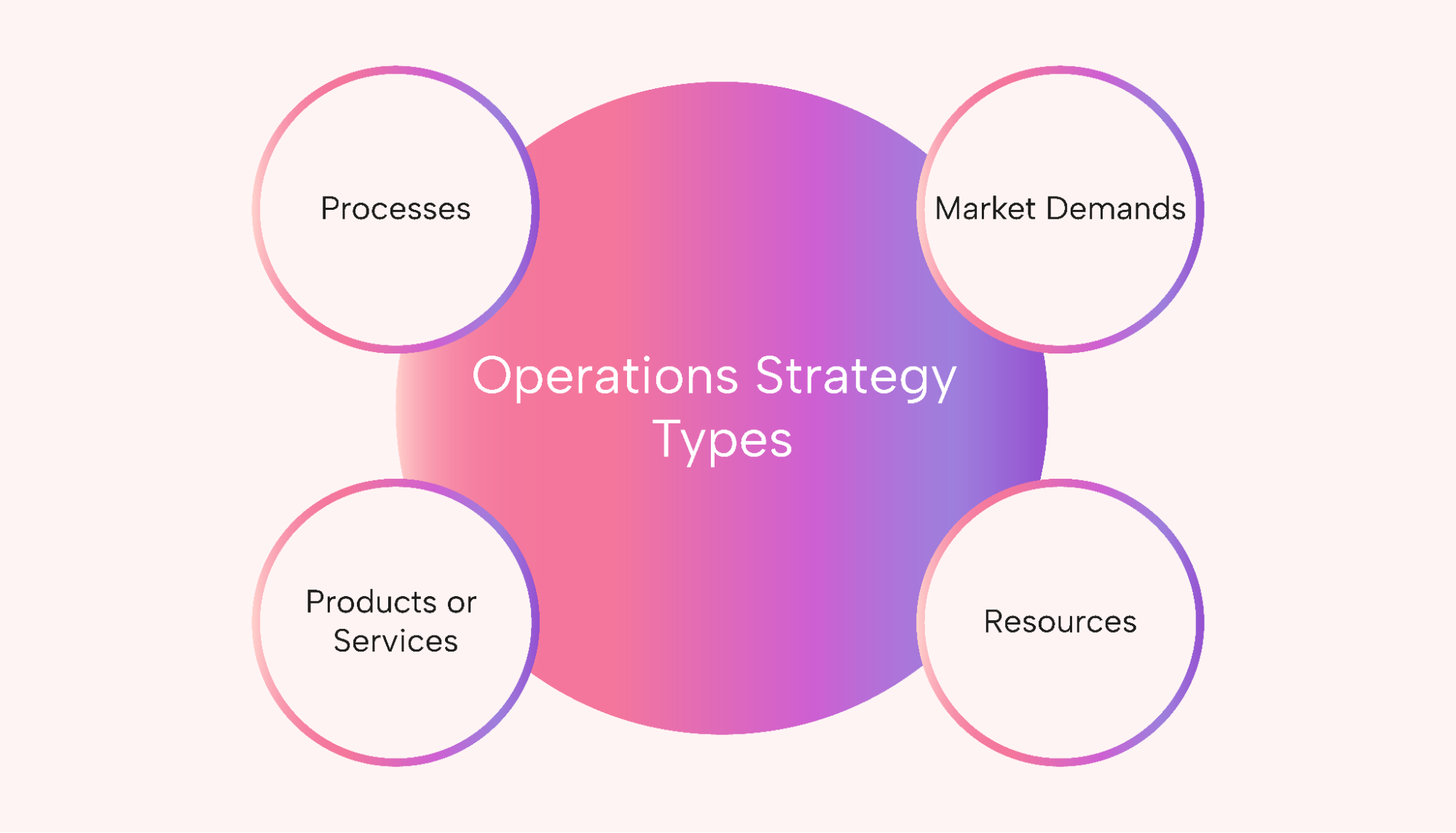Everyone wants to revolutionize their businesses with operational efficiency. However, small businesses often grapple with limited resources.
Fortunately, a solid operations strategy can solve this challenge.
A good operations strategy is more about thinking clearly and creatively than it is about having endless capital or resources. It’s an intentional plan for optimizing your day-to-day tasks and achieving your goals.
Let’s look at what an operational strategy contains and what you need to develop an impactful one.
What is an operations strategy?
At its core, an operations strategy is a blueprint. It’s how a business manages its resources to meet its objectives.
In other words, it defines how an organization creates and delivers value to its customers.
An effective operational strategy helps companies ensure all processes function efficiently and remain aligned with the company’s overarching goals. It becomes the bedrock of the company’s competitive advantage and customer satisfaction.
There’s no one-size-fits-all solution when it comes to operations strategies. Each one is a tailored plan that considers the company’s unique strengths, challenges, and market position — and guides it toward sustainable success.
What is the difference between strategy and tactics?
Strategy is the grand vision. It’s the business’s long-term goal or aspiration.
Tactics are the specific steps and decisions made daily to make sure the company moves toward its strategic milestones.
For example, if you wanted to become the leading luxury real estate office in your area, here’s how your strategy and tactics would differ:
Strategy: To become the top authority in luxury real estate transactions in the region. The aim is to have the most listings and sales for properties valued at over $1 million within the next three years.
Tactics:
- To build strong relationships with high-end property developers and homeowners through networking events
- To offer specialized training to agents focusing on the luxury market’s nuances and clientele
- To invest in high-quality photography and videography to showcase homes well
Types of operations strategies
These are four different classifications of operations strategies, and each has a different focus.
Process-based
Process-based operations strategies are focused on streamlining and optimizing processes and workflows. They’re about providing efficiency throughout the business’s operations.
Market-based
Market-based operations strategies are focused on tailoring operations to specific market demands. They’re about ensuring responsiveness and customer satisfaction.

Resource-based
Resource-based operations strategies are focused on maximizing the potential of available assets. They’re about doing your best with your physical, technological, and personnel resources.
Product- or service-based
Product- or service-based operations strategies are focused on innovating and improving the product or service offered to customers. They’re about remaining relevant and competitive.
Why is an operations strategy so important?
In today’s competitive landscape, an operations plan is crucial to not just survive but flourish. Let’s discuss the three key benefits of these strategies.
Benefit #1: Growth and innovation
Here’s a startling statistic: nearly 40% of CEOs don’t think their companies will be economically viable a decade from now if they continue on their current path. This underscores the need to adapt and grow into the future.
Refining your operations can lead to higher efficiency. And not only is efficiency good for reducing costs, but it also provides you with the foundation and breathing room to expand and innovate.
Benefit #2: Operational bottlenecks
An effective strategy identifies potential chokepoints and hurdles. Whether the problem is supply chain issues or service interruptions, a well-designed business strategy seeks out these inefficiencies. Then, it creates solutions to mitigate or remove them.
So, for instance, if a manufacturing company found a bottleneck in the finishing stages of its process, its strategy might include hiring temporary workers in the short term and upskilling existing employees in the long term.
Benefit #3: Customer satisfaction
At the end of the day, every operational decision has a ripple effect on the customer.
That may be:
- The speed of delivery
- The quality of a product
- The personal touch of a service
However, these effects add up to long-term brand loyalty and consumer trust.
BCG’s Build for the Future survey found customer experience was the highest priority investment of leaders today. It also found that the most successful companies invested more in customer experience than their competitors.
That leads to:
- More value
- More growth
- More trust
What are the key elements of an operations strategy?
So what should your operations strategy include? Here are eight essential elements you should have in yours:
1. Vision and objectives
Every strategy begins with a clear vision and measurable objectives. This includes defining specific outcomes for the business and deciding on the metrics so that you can track your progress toward those objectives.

Examples include the following:
- Increasing market share
- Entering new markets
- Optimizing current processes
2. Demand forecasting
This element seeks to understand future demand and anticipate needs. That means looking at data like past sales figures or rates of growth, market research, or customer surveys to understand shifting preferences.
For instance, a retailer might analyze historical sales and market trends to predict future top-selling items.
3. Capacity planning
Capacity planning strives to meet demand with adequate resources. Here, you’ll need a clear assessment of your current staffing and capabilities.
Your strategy may involve hiring more staff, expanding facilities, or investing in training.
4. Supply chain management
This step involves a deep dive into your entire supply chain and how to optimize it. That means identifying vulnerabilities or opportunities. Your focus is on evaluating your vendors and transportation logistics, as well as how you manage your inventory.
5. Process design and improvement
In this step, document and evaluate your primary business processes. Use methodologies like Lean or Six Sigma to identify waste or pinch points.
An ecommerce platform might assess checkout procedures to make the process quicker for users.
6. Quality management
This element includes quality standards and mechanisms for reviewing quality.
That might mean:
- Setting clear specifications for a product or service
- Holding regular training sessions
- Creating feedback loops with customers
7. Technology and innovation
This part of the strategy identifies areas where your tech can drive efficiency.
That could include investments in automation, integrating analytics into your processes, or setting aside resources for new R&D.
8. Risk management
A good starting point would be a Strengths, Weaknesses, Opportunities, and Threats (SWOT) analysis. Use that to identify internal and external risks.
Then, develop contingency plans such as the following:
- Diversifying suppliers
- Creating an emergency fund
- Developing rapid-response teams
How to implement an operations strategy
Any leader will tell you that it’s one thing to develop a strategy, but it’s another thing to enact it. This section will give you a simple, effective guide to implementation.
Step #1: Assess your current state
Start with a clear understanding of where you are. Complete an internal audit by looking at your current operations in-depth. Check for gaps, inefficiencies, and strengths.
Then, consider external forces such as market dynamics and competitor strategies. These variables can heavily influence your strategy. You can use a Political, Economic, Social, Technological, Environmental, and Legal (PESTEL) analysis or other tools to assess external key factors.
Step #2: Develop a clear roadmap
Next, break down your journey into smaller, achievable goals.
Set milestones. Plan out how to allocate resources for each step in the process.
In other words, take your strategy and split it into actionable tasks. Every task should have clear standards for success, a deadline, a clear budget, and an assigned team member.
Use the Eisenhower Box or a similar tool to decide which tasks you want to prioritize.
Step #3: Engage your team
No strategy is executed in isolation. Your team is a crucial element in bringing your plans to life.
First, invest in training to ensure everyone understands and is equipped for their role in the new strategy. And remember, change can be unsettling.

Do the following:
- Communicate the “why” behind changes
- Provide ample support
- Create channels for feedback
With its robust communication channels and extensive task management capabilities, Motion is a great tool for getting your team on the same page.
Step #4: Review and refine
There’s an old saying that what gets measured gets managed. Implement systems for continuous monitoring to review your progress against your goals.
Celebrate and strengthen your wins. And, even more importantly, identify and correct your losses.
Also, establish a culture of flexibility so that you can change course quickly when needed.
What are some examples of companies using an operations strategy?
Let’s wrap up our discussion with some real-life examples of operations strategies at work in well-known companies.
Amazon
Amazon has revolutionized its supply chain and operations strategy through its Prime delivery service.
The ecommerce giant optimizes warehouses with advanced algorithms and robotics. This strategy reduces delivery times, manages proper inventory, and satisfies customers.
Starbucks
Starbucks’ business strategy revolves around a seamless customer experience and an efficient supply chain.
It prioritizes:
- Ethical sourcing
- High-quality coffee beans
- Employee training
Additionally, Starbucks’ store layouts are designed to optimize workflow and enhance the customer’s experience, from ordering to pick-up.
Apple
Apple designs its strategic plans to uphold its reputation for quality.
It maintains a tight grip on its supply chain and ensures its products have high-quality components. It also focuses on optimizing inventory. For instance, it produces just enough items to meet demand, minimize storage costs, and keep products fresh.
Take your operations to the next level with Motion
Now that you know how to create and implement your operations strategy, let’s talk about digital tools.
At Motion, we know how to revolutionize operations because that’s what we do every day. Our powerful AI software builds out a schedule for your team so you can get more done in less time.
Our task and project management features are integrated into your calendar. We’ll help drive productivity and efficiency for your team. Try us out today.





